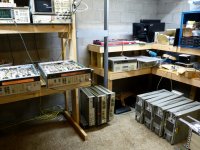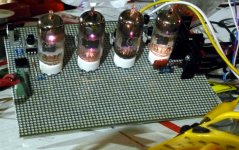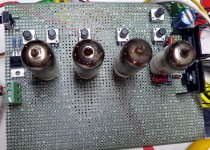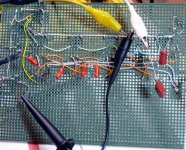I only have a little experience coding for microcontrollers, but it is certainly a different kind of game, when you have no operating system to do all the background chores for you.I bought an arduino the control my mash-tun
I used to love coding at one time. Eventually I realized it was destroying my body (carpal-tunnel, other RSI, lack of exercise), destroying my free time (what free time? Coding soaks up all your time), destroying my social life, destroying my abilities as a musician (I was coding instead of practicing), and destroying my connection with nature.
It's a lonely life, living with your head stuck inside a tin box full of digital bits, isolated from the world around you.
It's not for me any more. When I'm not working, I'd rather be enjoying my wife's company, playing guitar with my friends, watching the deer come out to eat at dusk, or trying to get another watt out of a 6BK5.
-Gnobuddy
I don't know much about tube testers, unfortunately. But I keep finding little bits of gear I wish I had: a small audio signal generator that can put out up to 10V RMS sinewaves, a way to generate sine tone-bursts from the signal generator, a simple speaker test setup (for measuring speaker fundamental resonance frequency and/or other Thiele-Small parameters), et cetera, et cetera.oh and test equip sounds good I need a good tube tester
I'm sure that many people who've been tinkering with tubes/valves for a long time have come up with some clever little tools-of-the-trade of their own invention. Maybe we could share some of those ideas here.
-Gnobuddy
watching the deer come out to eat at dusk
We had 6 deer come to eat most every night in our backyard. Between hunting season and being run over by pickup trucks, there are now 3. The big buck's head is probably hanging on someone's wall by now.
or trying to get another watt out of a 6BK5.
I picked up 270 cheap tubes last time I was in Florida at ESRC. Unfortunately I haven't put power to any of them yet......soon. I really want to make a vacuum tube ladder filter, that's what some of those tubes were for.
I don't know much about tube testers, unfortunately.
At one time I had 3 tube testers. One basic emission tester, and two transconductance testers. I found that none of these could reliably weed out all bad tubes. I had a big bag, maybe 250 used 6U8 tubes and a KT88 HiFi amp design that used them. I ran all of the tubes through the amp, testing for DC voltages, gain and distortion. I ran maybe 30 or 40 tubes through the amp, ran the stats for all the tubes using the 6 sigma tools that I had been taught during my engineering career at Motorola to determine the specs needed to ensure that every tube that I tested would work in the amp.
I then ran all of the tubes through the amp, and tested each one to those specs. There were maybe 20 tubes that didn't make the cut, each rejected for one or more out of spec parameters. None of the tube testers could reliably find those bad tubes, and one of them failed several good tubes. The transconductance testers did a decent job of finding the tubes that failed the DC specs, but couldn't find those with high distortion, and some were really bad.
After that experience, maybe 12 years ago, I sold all the tube testers.
Another forum member who wants to remain anonymous has sent me a vacuum tube curve tracer. I had about a day to play with it last year, but it really needs to find a spot on a workbench and a dedicated oscilloscope. I really want to run a big bag of tubes (I have several) through a curve tracer then stick them all into a working circuit. That will be a learning experience, then maybe we can all figure out how to build a tube tester that really works.
tinkering with tubes/valves for a long time have come up with some clever little tools-of-the-trade of their own invention.
Most of the time I work with one or more bench type power supplies, all Ebay or Hamfest sourced old stuff, a scope and a handful of $4 digital multimeters. I also have an old HP 8903A distortion analyzer and a HP204C audio oscillator. You can do a better job at making the same measurements with a PC and some software.
When designing an amp from scratch, I dial everything in with external power supplies to figure out what the circuit really likes, and then design a power supply to give me those voltages. Sometimes it's an iterative process if there's no cheap transformer to get me there.
I used to love coding at one time. Eventually I realized it was destroying my body
Sitting in general for long periods of time is bad. Sitting and staring at a glowing plastic window into a virtual world is probably worse.
I worked in an RF IC design team at Motorola. I used to design RF circuits and microprocessor controlled stuff for testing and evaluating our chips. I created "reference designs" to showcase their abilities. Often these reference designs were fully functional multi band two way radios. This stuff came easy to me, but that was 3 years ago. In that short time I find that I have lost a lot of that mental sharpness, so I'm thinking about designing a ham radio or something like that just to see if I still can do it.
playing guitar with my friends,
I went through a period of time where I was having serious pain and numbness in my arms, hands and fingers. At one point I couldn't even drive a car, much less play the guitar. After giving up on doctors who just wanted to feed me more pills, a frustrated internet search led to the discovery that all of this was caused by a beta blocker medication that I had been taking for 25 years. Within a couple of weeks of stopping the med, all the pain vanished, and most of the major numbness is gone. Winter was always worse case, but so far so good. My fingertips are still numb enough that I drop things, can't get the key into the door lock, and have trouble with the guitar, but hey it's a major improvement. Soldering used to be impossible, but I have wired up the synth and only soldered my fingers a few times.....about normal for me. I'm even going to try SMD stuff again. Still have to proof read and correct an awful lot of my typing though.
Then I read about how Keith Emerson ended his life due to pain and numbness in his arms and hands, and wonder....did he take the same stupid pills?
No deer in our pocket-handkerchief sized yard, but there is a big park and open farmland within a few minutes drive. Last time there, a doe came out of the shadows and ended up grazing in the ditch less than ten feet from our idling car. I guess she was hungry (snow on the ground) and used to cars.We had 6 deer come to eat most every night in our backyard.
Now, that's a bit bothersome!None of the tube testers could reliably find those bad tubes, and one of them failed several good tubes.
So much for the supposedly universally-applicable three-halves power rule for triodes?couldn't find those with high distortion, and some were really bad.
Do you happen to know what causes that sort of high distortion in a tube? Perhaps misshapen or misaligned electrodes? Presumably you have to somehow generate an abnormal electric field inside.
I want to do things like quickly find the right value of small-signal pentode screen grid decoupling cap to get bass response down to 80 Hz.You can do a better job at making the same measurements with a PC and some software.
For this sort of thing, I decided a small analog audio signal generator would be quicker and more convenient than a PC (plus mouse, keyboard, display, external buffer electronics, etc, etc).
I would actually love to pair that sig-gen with an old-fashioned AC analog meter that reads in decibels. They don't make those any more, and I have zero budget right now. Mebbe I can cook up something that goes between the audio signal and a cheap DMM on DC V range, so that if the meter reads "-3 V", it means "-3 dB".
I love the idea, but have no suitable external power supplies. Mebbe I should slap some diodes and caps on a Triad N68X and make a (fixed) bench supply with roughly 160V DC and roughly 320V DC.When designing an amp from scratch, I dial everything in with external power supplies to figure out what the circuit really likes, and then design a power supply to give me those voltages.
Just had an interesting idea. Why not put a power MOSFET in series with the rectifier diode(s), and turn off the MOSFET whenever the filter cap charges up to a preset voltage? A sort of crude 120 Hz switching regulator to let you dial-a-voltage up to the maximum you'd normally get from that particular transformer and rectifier arrangement?
I'm not normally in favour of lawsuits, but in this case, I really wish someone had awarded you a couple of million bucks for the (literal) pain and suffering they'd caused you over the years.all of this was caused by a beta blocker medication that I had been taking for 25 years. Within a couple of weeks of stopping the med, all the pain vanished, and most of the major numbness is gone.
It may be a couple of days, but I'll try to make sure there is actual guitar-related electronics content in my next post. I don't want this thread to end up getting moved to "The Lounge".
-Gnobuddy
I'm not normally in favour of lawsuits.......
I'm not either, and I'm not looking to sue anyone. I just wish I figured out what was going on a lot sooner. There is still something wrong with my cardio pulmonary system since I have been known to turn blue from time to time. Blue spots will develop on the skin surface over any muscle that I work hard......IE my shoulders will develop blue patches, which will eventually grow to cover my entire shoulders when shoveling snow for an hour or so. It's been going on for 30 or more years, so it's not going to be found now.
It may be a couple of days, but I'll try to make sure there is actual guitar-related electronics content in my next post. I don't want this thread to end up getting moved to "The Lounge".
Yeah....I have some tube stuff in the works, but right now my workbench looks like a 1990's vintage Hewlett Packard repair shop. Need to fix up some of this stuff for the upcoming hamfest season. Whatever I sell will pay for this years projects, and to keep Tubelab alive or at least one more year.
Attachments
Moving back to the topic at hand, a chap downunder has spent some time looking at cheap SE OPTs and found that 12V downlight transformers work rather well.
See this thread Background to a new SE amplifier on Aussie Guitar Gear Heads
See this thread Background to a new SE amplifier on Aussie Guitar Gear Heads
Very cool!...12V downlight transformers work rather well.
I used to be an AGGH member, and I'm familiar with Grant Wills' amazing ability to conjure up good-sounding amps from a handful of improbable components.
I wish those halogen transformers were easier to find around here. I've not had much luck so far.
-Gnobuddy
I got a stupid idea into my head. It wouldn't go away, so I had to build it. Of course it didn't do quite what I planned, but it did have a WHOLE bunch of gain. 10 mV of input gives 100 volts of output. I now have a few dozen more ideas to try, but this design is a dead end.
Now does anybody have an idea as to what it was supposed to be?
Now does anybody have an idea as to what it was supposed to be?
Attachments
Yes, all 4 tubes are wired together as a really tall cascode stage, or two of them in a balanced setup. It was my first attempt at a vacuum tube Moog ladder VCF for a music synth. It did actually work, but the plate resistance of the wimpy TV tuner triodes doesn't vary enough to cover even one octave, so it has been deemed a dead end.
I will rip it up and rewire it several times before I either make a good filter, a pile of dead parts, or a scrap piece of well used breadboard.......probably all 3. I have one dead tube already. One heater doesn't light up in the twin triode. Either it was dead from the start, or a seriously violated HK voltage spec helped it die.
Since it isn't a sub $100 guitar amp, I dug up a 2 1/2 year old vacuum tube modular synth thread and stuck my experiments there. That's where my future exploits with this board will be posted.
I will rip it up and rewire it several times before I either make a good filter, a pile of dead parts, or a scrap piece of well used breadboard.......probably all 3. I have one dead tube already. One heater doesn't light up in the twin triode. Either it was dead from the start, or a seriously violated HK voltage spec helped it die.
Since it isn't a sub $100 guitar amp, I dug up a 2 1/2 year old vacuum tube modular synth thread and stuck my experiments there. That's where my future exploits with this board will be posted.
hi everone....I just finished another little gem made with 10gk6 tubes....
10gk6 is the same as 6gk6 but with 10v required on the heater filaments...
6gk6 is a ever so slightly more robust version of the el84 and spec wise almost identical.
one can easily sub them for a el84 build with no issue(different pin out though)......and theyr'e just $5 each on average although some prices are crazy but no doubt you will find some at the right price...
if you have a chassis that has a 5v winding for a rectifier that is not being use then just add it to the 6.3 and bingo 11.3v...put a couple of big diodes in the path and drop it by .7 and its perfect.... you can now switch between 10gk6 and 6gk6
The amp I just finished uses two toroids... a 9v and a 90v which had its power tripled to around 360vdc.....they were on sale at altronics some time ago and cost just $55...
the 10gk6 ran sweetly on 9.3 v and after rectified gave me 11.9, for the 12ax7's
The amp I made is a 36watt tmb but I had to buy a 1760 J Hammond for it and that was the dearest item......definitely not a 100 buck amp but definitely worth consideration.
10gk6 is the same as 6gk6 but with 10v required on the heater filaments...
6gk6 is a ever so slightly more robust version of the el84 and spec wise almost identical.
one can easily sub them for a el84 build with no issue(different pin out though)......and theyr'e just $5 each on average although some prices are crazy but no doubt you will find some at the right price...
if you have a chassis that has a 5v winding for a rectifier that is not being use then just add it to the 6.3 and bingo 11.3v...put a couple of big diodes in the path and drop it by .7 and its perfect.... you can now switch between 10gk6 and 6gk6
The amp I just finished uses two toroids... a 9v and a 90v which had its power tripled to around 360vdc.....they were on sale at altronics some time ago and cost just $55...
the 10gk6 ran sweetly on 9.3 v and after rectified gave me 11.9, for the 12ax7's
The amp I made is a 36watt tmb but I had to buy a 1760 J Hammond for it and that was the dearest item......definitely not a 100 buck amp but definitely worth consideration.
definitely not a 100 buck amp but definitely worth consideration.
This challenge was started in response to someone who had built a low $$$ amp and stated that nobody could build a better one for less $$$. Some heated discussions ensued in the original thread, and this "make an amp for $100" challenge was started. Several amps were made including my two. Due to the squeezing of all the $$$ out of an amp, some of our creations worked, but didn't see much action. I decided to rip my really cheap (under $50) amp apart and add a few $$$ worth of parts to make it into something I would use often. I succeeded, and now have a little 4 watt amp I use often.
I stated this in post #1625:
Nobody is enforcing the rules any more. This thread was about making a playable guitar amp for a budget of $100. Unless anybody cares, maybe it should now be about an amp you would really want to use for minimum $$$$. Several good ideas were spawned here and a few amps were made. How many of those amps still get used?
And this was added to post #1 my the moderators:
Back then, several compromises were made in our designs to fit the budget. Now that we aren't constrained, we can use the parts we like to get the tone we want...Bring on the 12AX7's and the real OPT's, if that's what works. Anyone and everyone is welcome to play along...rules, we ain't got no stinkin rules!
So, if you have a "budget" amp, that you like, and actually use, by all means it is now welcome. Note that "budget" is now undefined, but seriously expensive designs probably don't apply.
I am still looking for the "18 watt Marshall" TMB prototype that I made for the original challenge. I think I had squeezed it into the $90 something range, but the $2 input tubes were terribly microphonic. When I find it and its bigger sweep tube brother, they will come back to this thread.
the tripler
With the tripler I was carful not to put too much capacitance into the stages so as simulate tube rectifier.....and I think it worked as there appears to be a modest amount of compression occurring noticeably when power chording and soloing
Its hard to know exactly what vdc you will end up with when you go this way....when standby is off the tripler will go as high as 400vdc but when in service will drop to 340vdc.......the calculated voltage was 378vdc
Also lastly....the stages in between the tripler will yield 126vdc and 252vdc...252vdc is handy for PI and preamp application
The amp I just finished uses two toroids... a 9v and a 90v which had its power tripled to around 360vdc.....they were on sale at altronics some time ago and cost just $55...
With the tripler I was carful not to put too much capacitance into the stages so as simulate tube rectifier.....and I think it worked as there appears to be a modest amount of compression occurring noticeably when power chording and soloing
Its hard to know exactly what vdc you will end up with when you go this way....when standby is off the tripler will go as high as 400vdc but when in service will drop to 340vdc.......the calculated voltage was 378vdc
Also lastly....the stages in between the tripler will yield 126vdc and 252vdc...252vdc is handy for PI and preamp application
Last edited by a moderator:
I believe to renew the interests, some new criteria have to be given, e.g., even lower cost, battery-powered, etc. One shortcoming of the previous contest appears to be the lack of a judging panel - who’s to say if a design is good or not when nobody seems to agree on what sounds the best or the most versatile, etc. IMO, the judges should be professional musicians not amp designers/builders. Anyway, just some ideas.
For me, what made the thread interesting was seeing lots of non-traditional ideas, ranging from unusual circuit topologies to oddball valves to unusual construction methods to atypical speakers.
I'm not the competitive type, so having a full-on competition with rules and judges does nothing for me. But I know it is a great motivation for many people.
That said, I do believe that both the electric guitar and valve guitar amps now have one foot in the grave. There are fewer young people interested in either of them. The people who are still interested usually have grey or white hair, and tinker with guitars and amps out of love. (Which is not a bad thing, it's the purest and most powerful of human motivations.)
I have hopes that the thread might come back to life around new and novel ideas that people came up with for the love of the thing, and want to share for the same reason.
I'm always tinkering with ideas on paper, but have not followed enough of them through on the workbench to make it worth other people's time to share them. My fault entirely.
-Gnobuddy
I'm not the competitive type, so having a full-on competition with rules and judges does nothing for me. But I know it is a great motivation for many people.
That said, I do believe that both the electric guitar and valve guitar amps now have one foot in the grave. There are fewer young people interested in either of them. The people who are still interested usually have grey or white hair, and tinker with guitars and amps out of love. (Which is not a bad thing, it's the purest and most powerful of human motivations.)
I have hopes that the thread might come back to life around new and novel ideas that people came up with for the love of the thing, and want to share for the same reason.
I'm always tinkering with ideas on paper, but have not followed enough of them through on the workbench to make it worth other people's time to share them. My fault entirely.
-Gnobuddy
I had a daydream about making a little bedroom practice amp with a 'jazz' tone. A pentode for the input/gain and tone controls stage, maybe 3 watts output. Not designed to be a 'tube screamer' but rather a 'dark', clean tone with a lot of compression on sharp pick attacks (from voltage sag?). How to accomplish that?
I figure an SE EL84 or 6V6 would be good. Maybe a 6AU6A or 6AC7 input pentode. I think a sub-standard OPT would be best so that the bass gets loose and woolly, and the highs get rolled off (going for a 'mellow' sound).
Any ideas?
--
PS - My target would be to get the sound of an early 1950s Gibson GA-50, as played by Jim Hall back in the day. That was a PP 6L6GA with about 15 watts output. You can listen to the master Jim playing it in this clip:
Here's the schematic:
This is what the amp looked like:
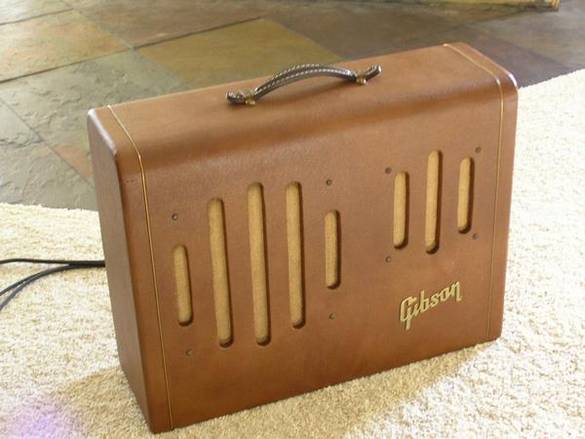
--
I figure an SE EL84 or 6V6 would be good. Maybe a 6AU6A or 6AC7 input pentode. I think a sub-standard OPT would be best so that the bass gets loose and woolly, and the highs get rolled off (going for a 'mellow' sound).
Any ideas?
--
PS - My target would be to get the sound of an early 1950s Gibson GA-50, as played by Jim Hall back in the day. That was a PP 6L6GA with about 15 watts output. You can listen to the master Jim playing it in this clip:
Here's the schematic:
An externally hosted image should be here but it was not working when we last tested it.
This is what the amp looked like:

--
Last edited:
I have much less experience than many people on this forum, but I find that small-signal pentodes easily produce that "compression on sharp pick attacks" you are looking for.Not designed to be a 'tube screamer' but rather a 'dark', clean tone with a lot of compression on sharp pick attacks (from voltage sag?). How to accomplish that?
This happens because of the very large value screen grid resistor. When you begin to overdrive the pentode, screen grid current increases, and because the screen grid resistor is so large, that causes lots of "sag".
From the schematic you posted of the GA-50, those screen grid resistors are 1 Meg. This is as big as anything I have seen, and I expect they would cause lots of sag!
Why not stick with the original GA-50 schematic from input up to the 6J5 (phase splitter) grids, and only change the phase inverter and/or subsequent output stages to lower the power? I bet a lot of the sound you're looking for comes from the preamp. By keeping that the same, you are more likely to capture the sound you're after.
Since you're unlikely to want to plug four instruments into your guitar amp today, you could probably also discard the upper microphone preamp channel (J4, the upper 6SJ7 that it's connected to, and all the associated passive components).
You can also toss J2 and J3, unless you expect to plug three guitars into the amp.
I notice that the input grid bias resistor is only 100k, so with the 47k grid stopper, your guitar will only see around 150k input impedance, much lower than the 1 meg we are used to nowadays.
I'll bet this lower input impedance is a big part of the reason for the darker sound you describe - guitar pickups lose treble if you feed them into too low an impedance. But what is wrong for country and pop and rock might be exactly what you want for jazz.
If you decide to keep the preamp design as is, ESRC Vacuum Tubes lists 6SJ7 pentodes for $4 ( Electron Tube List range 6K4 - 6ZY5G - Vacuum Tubes @ ESRC Vacuum Tubes ). These tubes will probably last at least a couple of decades each, so you could probably get yourself a lifetime supply for $18 plus shipping.
I'm a sucker for 6V6s myself, I've never heard one sound bad!I figure an SE EL84 or 6V6 would be good.
What's going on with that phase splitter, though? I can't quite get my head wrapped around it. Is that a paraphase? If so, you might want to follow the original schematic here, too. I've never used a paraphase, but supposedly they have a specific and different sound to more modern types of phase inverters - so if you want to keep the original sound, keep the original phase inverter, too.
That leaves the output stage and power supply as places where you can use your own ideas. If it was up to me, I would toss that entire power supply design, and design one with solid state diodes and no chokes. I also prefer to use a modern switching power supply (wall wart) to power the heaters; it's not easy to find a 6.3 volt one, but I've seen ones rated at 6V that actually put out around 6.3V, and I've also used an appropriate series power resistor to knock down the voltage from an 8V one.
You could also try this for a cheap, lightweight, efficient power supply: Amazon.com: Qianson High Voltage DC-DC Boost Converter 8V-32V to +-45V-390V Adjustable ZVS Capacitor Charging Power Supply Module: Electronics
That board is only rated for 40W output power, but I think that will be plenty to power a single-ended 6V6 amp, even after allowing for the horrendously poor efficiency of a class-A SE 6V6 stage. You could power that DC-DC board from an old laptop power supply, they are typically 18.5 V or 19V DC, right in the middle of the recommended 10V - 32V DC for the high voltage boost converter.
I think the finishing touch would be to find an old brown suitcase in a thrift-store, and modify it to house the amp!
-Gnobuddy
The phase inverter is a simple paraphase.
Catching up on some of the posts. I have a few of the HV modules and want to build something this winter. For the heater I don't bother with 6V, 12V is much easier to deal with and 12V6's work just as good and are still reasonable in price.
Catching up on some of the posts. I have a few of the HV modules and want to build something this winter. For the heater I don't bother with 6V, 12V is much easier to deal with and 12V6's work just as good and are still reasonable in price.
Last edited:
- Home
- Live Sound
- Instruments and Amps
- The Hundred-Buck Amp Challenge
